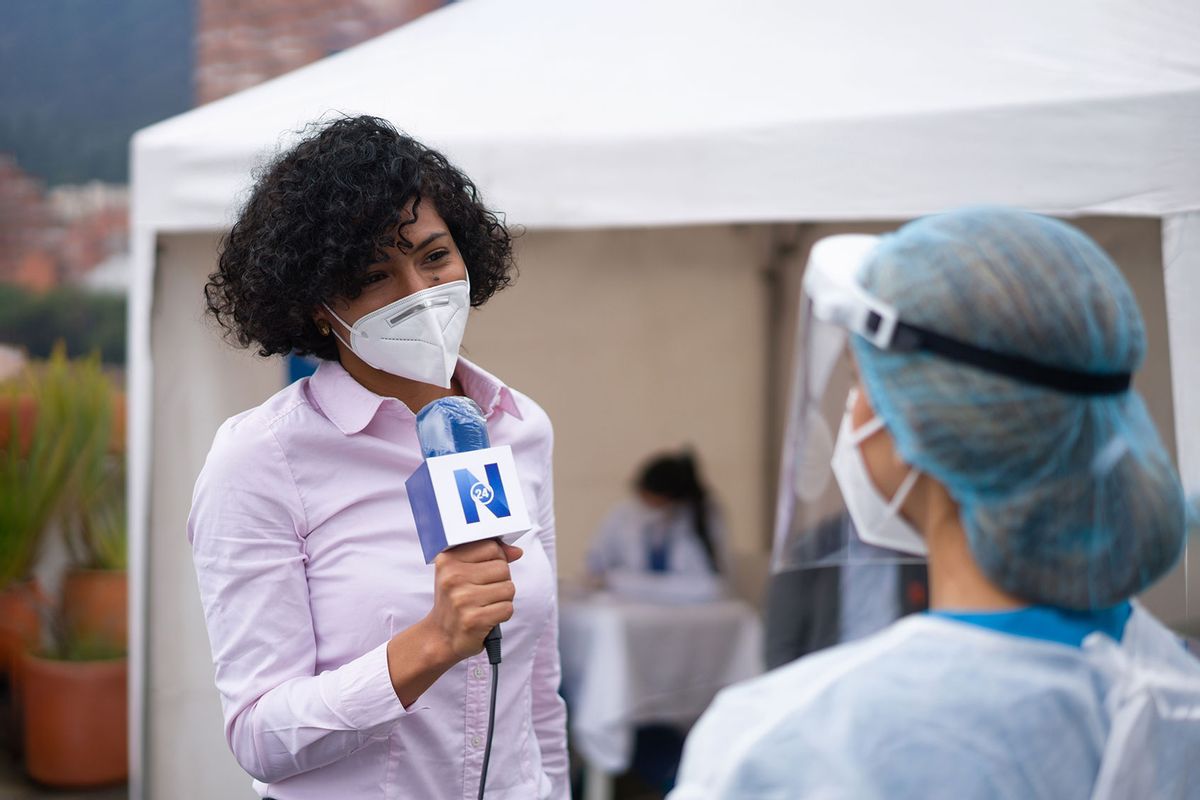Black women are vital to science and health journalism

A quiet panic started happening sometime last summer in the world of science. The root of the issue began long before that, but by October 2023 it could no longer be ignored: People don’t really trust science anymore. More specifically, a growing chunk of Americans who lived through the peak global impact of COVID-19 now steeply distrust western medical sciences, including (you guessed it) public health institutions focused on epidemiology and pharmacology. That’s as dangerous for people’s daily lives as it is for any future public investments toward critical research.
And if you attend any of the major science conferences this year, you’re likely to see at least one panel of predominantly white, male big-wigs nervously wringing their hands over what to do about it all. You’ll probably hear them point to a few unsurprising culprits behind the credibility gap which, to be certain, do have a heavy hand in it: intentional political disinformation campaigns and infodemics, predominantly Republican anti-science stump speeches, private companies angling to profit off the fearful and uninformed and sensationalized headlines that get the story wrong.
Sure, those things all need fixing and the problem isn’t single-faceted. But there’s one culprit missing here that isn’t talked about enough, and I hope they’ll address it first. It’s the biggest problem I can see from my crow’s nest view as a professional info-intermediary in the science-to-public pipeline. It’s also the easiest problem to solve, with the highest likelihood of improving outcomes for all other proposed solutions: Put more Black women in charge. Now.
The people you can persuade with facts are already on the side of science and journalism, and they are not impressed with your racial methodology.
The lack of Black women in positions of leadership and executive authority — across all scientific and science communications fields — is the biggest hole in the metaphorical credibility bucket. Public health organizations and journalism outlets can’t ask the world to believe that they’re producing objective science and fair journalism when they can’t even accomplish objective and fair hiring. Likewise, you can’t ask the world to believe this trust problem is simply manufactured by evil political forces outside of their white-led institutions when anyone can see that internal political ideology (or just plain white laziness) is encouraging rightful distrust among those who may otherwise politically champion both science and journalism.
So white-dominant organizations and media outlets want to restore wider public trust in science? Good. To them I say: The call is coming from inside the house. If you would clean up the world, sweep your own doorstep first. Stop worrying about what Fox News is doing and what their Twitter devotees believe. That’s a red herring designed to make you waste money and time playing Whac-a-Mole against bad-faith spin doctors. All because you think you can persuade right-wing ideologues and their fanclubs to believe in scientific and journalistic facts — by presenting them with more facts.
Want more health and science stories in your inbox? Subscribe to Salon’s weekly newsletter Lab Notes.
Well, honey, let me tell you a little secret: That audience is not persuaded by facts, but by feelings. And their feelings are so easy to manipulate that if I wanted to cause a five-alarm riot during family dinner, all I’d have to do is pay a couple GOP operatives to go on a 7 o’clock Fox broadcast and say “masks are the AR-15s in the Republican war on COVID, and Jesus died for my American right to bear them arms in Wal-Mart.”
The people you can persuade with facts are already on the side of science and journalism, and they are not impressed with your racial methodology. Just look at the findings from Pew Research in 2023:
Are we surprised that news and information patterns among Black families during peak COVID-19 had such wide diversion from those of white families? We shouldn’t be.
“Just 14% of Black Americans are highly confident that Black people will be covered fairly in their lifetimes, saying that is extremely or very likely to happen. Far more (38%) think that is not too likely or not at all likely to happen, while an additional 40% say it is somewhat likely … a lack of Black staff at the news outlet (36%) are major reasons for racist or racially insensitive coverage.”
“About a quarter of Black Americans (24%) say they extremely or fairly often get news from Black news outlets” Pew said in its 2024 analysis. “Another 40% of Black adults say they sometimes get news from such outlets.”
40% of Black people surveyed also told Pew that it’s crucial for race-related news to come from a Black writer.
“Similarly, just 15% of Black Americans say that whether a journalist is Black is extremely or very important to deciding if a news story in general is trustworthy,” the report said. “Substantial shares also say… hiring more Black people as newsroom leaders (53%) and as journalists (44%) at news outlets would be highly effective.”
And how are we doing on the hiring numbers? Black women are only seeing rare wins in science journalism. We have to do better. Newslab has been tracking the stats:
“A 2018 survey by the American Society of News Editors found only 7.19% of full-time newsroom employees were Black. Only about 20% of those Black employees were in leadership positions, and there is no data on how many of those leaders are Black women.”
No data? In 2018? Incorrect. In an archived copy of that 2018 survey, you can see Black women account for only 3.45% of that 7.19% number above. And a table labeled “whites and minority percentages among newsroom leaders” reports that Black women held only 3.13% of leadership roles in 2018 and 2.16% in 2017. Are we surprised that news and information patterns among Black families during peak COVID-19 had such wide diversion from those of white families? We shouldn’t be.
So forget Fox. Start worrying about whether your hiring process and workplace structure is engineered to attract the best talent from anywhere — or whether it’s designed to only attract the best talent you can find in a teensy pool of applicants who meet demographically isolated class criteria, and thus almost always end up being as white as a Boston cop.
“Inequality belongs as a subject within science and for science journalists to cover,” said Pulitzer Center grantee Amy Maxmen in 2022.
“It’s often about geopolitics and economics and history and culture — more than science as you might have had it in a classroom,” she said. “But if you believe that the point of science is progress, which is what I believe, then there’s not going to be progress if the fruits of science aren’t widely distributed to people.”
“Science has not simply been a bystander to racial violence, but has, in many ways, created the alibi.”
“Meanwhile,” as Sydette Harry wrote for Wired in 2021, “marginalized young journalists, specifically young Black women, are barely quoted anywhere in the media, even as they are pushed out of newsrooms at an alarming rate … From ethics in AI to abuse on social media, the reality is that none of this can continue without looking at the entire bedrock of not just tech, but those who charged themselves with covering it and the world it is in.”
That’s because science and journalism both have the same Achilles’ heel — a claim to be rooted in seeking objective truth, but then not being objective about who decides what’s true.
“Science has not simply been a bystander to racial violence, but has, in many ways, created the alibi,” said Princeton sociologist Ruha Benjamin in 2020, pointing out how the person completing George Floyd’s preliminary autopsy report said he died of underlying conditions, rather than being killed by officer Derek Chauvin.
The global priority of all science and science journalism right now is (or should be) climate change and its effective coverage. Black women are more impacted by the climate-related fallout in this country than perhaps any other group — because, as we all know, climate-related fallout is either currently hitting, or predicted to hit, every single aspect of our daily lives in one form or another. And thus the groups who already have the short end of the stick right now are bound to feel that fallout first and worst.
In 2018, Talia Buford talked about how ProPublica came at this issue and why we have to keep at it.
“When we began our environmental coverage as an industry, people weren’t the focus. We talked about acid rain and the hole in the ozone and what’s happening to polar bears, as opposed to the impact on poor or vulnerable communities. Having a different perspective in the newsroom is important because it reminds you that there are different ways to look at stories. Having people of color in the newsroom is important because it changes the conversation,” she said. “I think that Black reporters and, really, reporters of color, are more well-versed in intersectionality and the idea that nothing happens in a vacuum. We’re able to draw from our own experiences — or at least things we’ve heard of and understand from our communities — to piece together what the different implications could be in a way that may not be apparent to other reporters.”
Enough with the infodemic hand-wringing. Enough with the political fretting. First, do the work that needs done for better science and better journalism: Center Black women in science leadership and communication — or nothing else will matter.
An earlier version of this article originally appeared in Salon’s Lab Notes, a weekly newsletter from our Science & Health team.
Read more
from Salon’s Lab Notes



